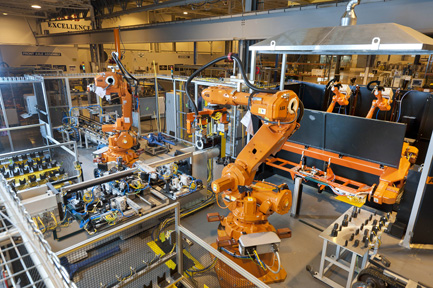Maintenance 4.0, for the worker of tomorrow
By Bruno Lhopiteau, GM of Siveco China
The world has known three industrial revolutions and the fourth one is well on its way. Dubbed Industry 4.0 by German industry strategists, it promotes increased computerization and integration of industrial systems. With Industry 4.0, all the latest buzzwords: Big Data, 3D printing, Internet of Things, Cloud Computing, Smart Factory, BIM and many more, get combined into one single concept or, as some contrarians might say, into one giant marketing gimmick (hence this article).
As often in China, this initiative has taken a life of its own and is seen as a silver bullet that will allow the country to leap-jump its current industrial challenges, straight into a future dominated by Chinese industrialists. And it may well prove to be true… as long as the crucial human obstacles we are facing are not ignored by technology-obsessed managers.

Industrial IT in China, mixed results

The basic principle of Industry 4.0 is that interconnected machines and systems will form an intelligent self-controlled network spanning the entire value chain. In the ideal factory, machines autonomously react to unexpected changes in production, predict failures and trigger maintenance processes. How does this Industry 4.0 dream of technology-enabled just-in time maintenance and near-zero downtime translate into our daily Chinese reality?
Anyone who has worked in the Chinese industry for any length of time has seen more than his share of fancy technology left unused because it failed to address local needs and relied on skills not readily available in China.
Industrial IT provides the best examples:
Lack of proper as-built documentation remains a major problem, which expensive BIM (Building Information Modelling) technology is not addressing.

BIM in real life
A reactive approach to maintenance is still the rule, while CMMS/EAM (computerized maintenance systems) are setup to automate these incorrect processes rather than inculcate best maintenance engineering practices.
Most Building Management Systems (BMS) do not fulfil their intended role, due to design mistakes and failures of sensors too complex or costly to maintain.
As more sophisticated and automated systems are put in place, companies become more reliant than ever on hard-to-find skilled maintenance managers, engineers and technicians. Overhyped plans to install millions of robots to replace decently paid Chinese workers have so far failed to materialize, perhaps because the required maintenance workers are nowhere to be found.
The challenge of maintenance
To succeed in China, Industry 4.0 should not ignore the maintenance challenge. In fact, Maintenance 4.0 lies at the core of this fourth industrial revolution. Instead of replicating a western model, as previous industrial IT initiatives have done, it must be redesigned to meet our Chinese needs.
Chinese engineers are generally too specialized and lack the multidisciplinary skills so crucial to manage maintenance: basic knowledge of mechanics, electricity, automation and an overall business view to understand the impact that maintenance has on the operations. The discipline is largely ignored by universities and, an even more acute problem, professional schools. The fundamentals of preventive maintenance remain largely unknown. Staff turnover is often an issue, especially with regards to skilled personnel and management staff. Maintenance is still considered a very unglamorous career choice. These are the very challenges that Maintenance 4.0 must address in this country.
In China, Maintenance 4.0 must kill two birds with one stone.
Maintenance 4.0 in practice
At Siveco, we have been practicing this Maintenance 4.0 “with Chinese characteristics” for many years, albeit under other names.
We use innovative technologies, designed by our Chinese R&D unit but backed by decades of experience in other markets, as a tool to enforce best practices from top management down to individual workers. Our bluebee® mobile solution “for the worker of tomorrow” requires technicians to scan asset tags (typically QR codes). This simple constraint helps drive a maintenance engineering project to draw up-to-date equipment lists, inspections points and maintenance instructions. Once in operation, it ensures technicians have actually performed inspections or preventive maintenance actions.

In the process, through the use of technology, the maintenance staff acquires new knowledge by applying best practices immediately on-the-job, which academic research and empiric results have shown to be most effective way to learn. Higher levels of motivation are usually observed, as workers feel gratified by the use of modern technology in the workplace and benefit from their upgraded skills.

With well-established processes and systems in place, companies also become less dependent on individual employees.
Hundreds of clients, thousands of technicians have used our solutions and have obtained measurable ROI, including leading multinationals operating in China, such as Essilor, Hanwha Chemicals or Nokia, but also local firms such as Fushun Mining, Greenland Property or Lutianhua. bluebee® has also won multiple industry awards in the past few years.
About the Author
Bruno Lhopiteau is the general manager of the country’s largest maintenance consultancy, Siveco China. He is a 15-year veteran of the Chinese market and also lectures on industrial risk management at the Sino-European School of Technology of Shanghai University.
Tags: Maintenance 4.0




